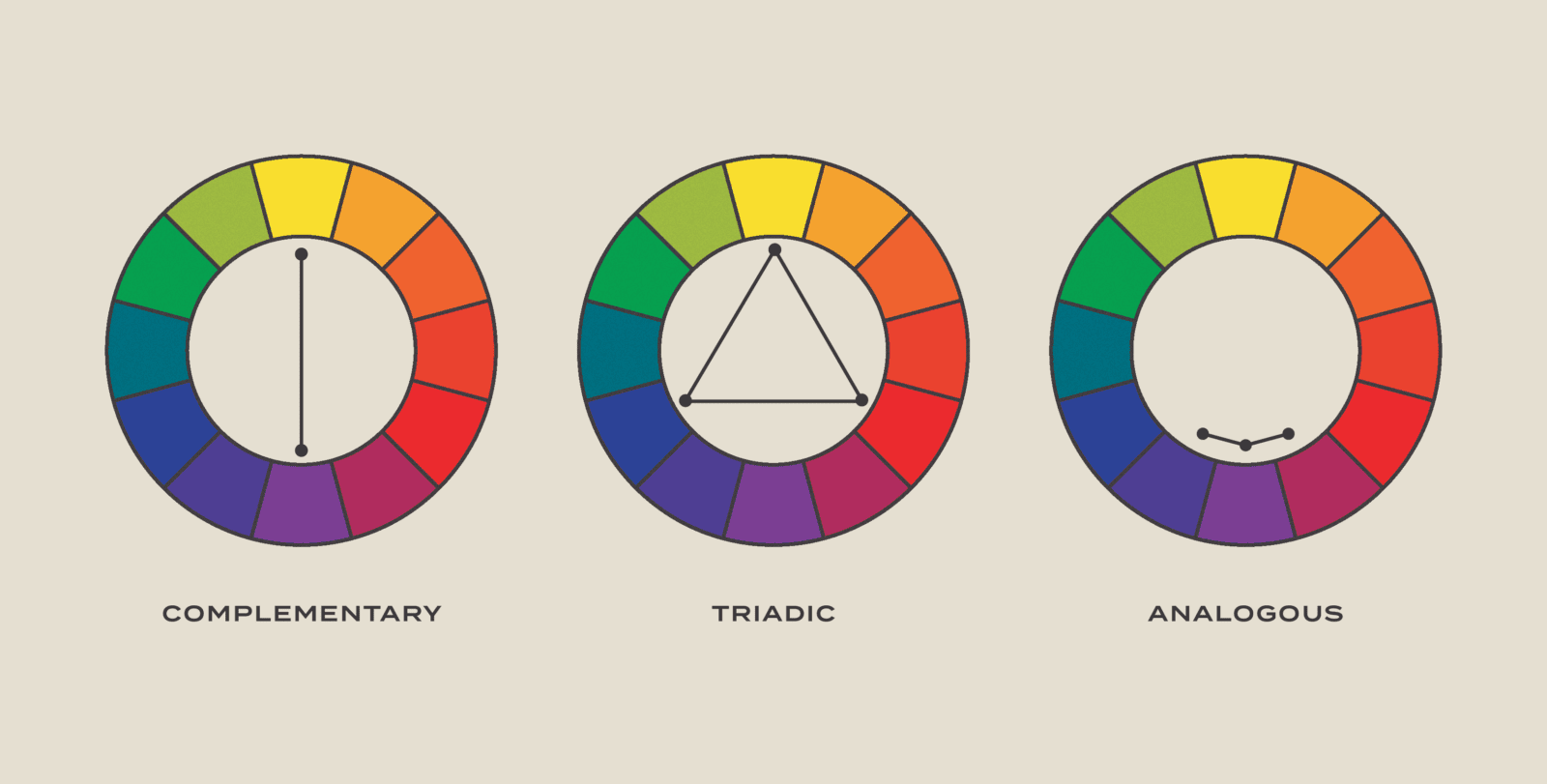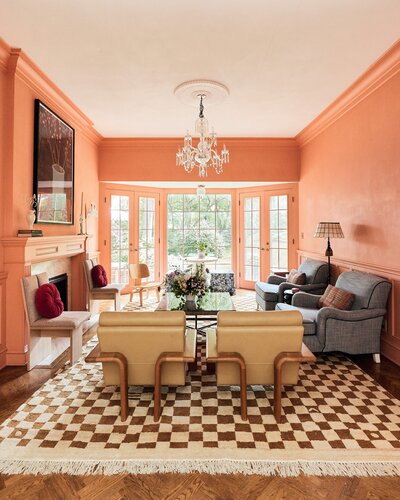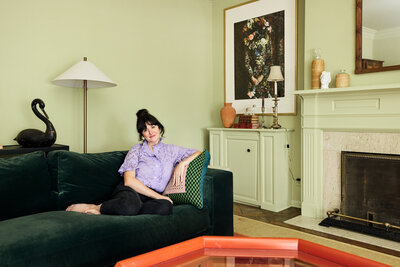

There are plenty of reasons people shy away from using color in their home decor and clothing choices. Personal preferences are often the reason cited by myself and others when explaining my black, white, and gray wardrobe, or our previous home’s generally neutral palette.
When we purchased our new home, it was initially a given that I would paint it all white, or some neutral shade. I thought having white walls would be the best way to start fresh. What surprised me, however, was how energizing the color in our home was and how it impacted my mood. That got me thinking about why we avoid big commitments like colorful paint. Aside from assuming we’re not “color lovers,” could the reason we avoid it also be in part that using colors requires a very different design process? Maybe one that, without some understanding of color theory, could be slightly intimidating?
I do believe one of the reasons we have been able to live with the bright colors on our walls is that I have some basic knowledge of color theory and that I’ve arranged the furniture we’ve collected over the years with color theory in mind.
So today, I’m going to explain a little crash course in color theory.
After reading, I’m hoping you’ll either feel more emboldened to paint an accent wall OR save your extra hours this summer enjoying the weather instead of sweating over a bucket of paint to hide already bold walls. I’ve chosen the latter option!
What is color theory?


Color theory is the science behind the way we process and interpret colors. It involves different types of color combinations, proportions of each color, and results in specific recommended uses of color. The best way to think of it is as a baseline for understanding general interpretations of color, because each of us is going to see color differently and assign it different meanings based on our experiences in and sensitivity to interior environments.
In short—the color wheel is a roadmap to understanding color and how we process it in specific combinations.
A little fun history fact—Sir Isaac Newton created the first color wheel and since then, artists, scientists, and other creatives have used it as a baseline, foundation, and framework for using color in a variety of mediums. In this case, we’re going to be talking about interiors.
Color theory is the science behind the way we process and interpret colors. It involves different types of color combinations, proportions of each color, and results in specific recommended uses of color.
The color wheel consists of three primary colors—blue, yellow, and red—from which all other colors are derived. When primary colors are mixed, they create green, orange, and purple. These are called secondary colors. And when secondary colors are mixed with primary colors, you have six tertiary colors, such as blue-green and red-orange.
Adding black and white changes the shade and tint of these twelve baseline hues, creating a whole world of complex design decisions to make.
The thing that helps me the MOST is considering color theory as a way to keep color selection less overwhelming. If you draw a line straight down the center of a color wheel, you’ll see cool and warm colors on either side. The color wheel will tell us that reds and greens will always create interesting harmony because they are what we call complementary colors—two hues placed opposite from each other on the color wheel.


Selecting complementary colors is a simple—and high-contrast—way to create a color scheme. A few of the other ways to select a color scheme include:
Triad: You can determine a triadic color scheme by drawing a triangle on the color wheel. This will result in a vivid, bold palette with contrasting hues that still complement each other well.
Monochromatic: To create a monochromatic color scheme, select one main hue and add in different shades (adding black to a hue), tints (adding white to a hue), or tones (adding gray to a hue). This will create a more subtle color scheme. You can see an example of how hues work together with shades and tints in the first graphic shown above.
Analogous: An analogous color scheme mixes colors that sit next to each other on the color wheel, such as red, red-purple, and purple, or blue, blue-green, and green.
There are no bad colors, just bad color choices.
Understanding that the psychology of color is baked into the color wheel helps give you the tools to make fewer mistakes. Where we go wrong with color is often in two areas: the intended use of the space (and the overall mood you’re needing to create) and the proportion of colors used based on the intensity of the hues.
How color sets the mood.
Color is so much more than personal preferences. When you are in a space, the way your eye translates color and the combination of colors impacts the way you experience the space—both your general mood and overall comfort level.


You might have negative memories or experiences from a space when you were a kid that impacted how you feel about certain colors today. If you’re a sensitive person, like myself, those experiences might be harder to put into words. This is where I like to start when thinking about design choices for a room, because without considering the intended use of a space and the mood you’re looking to embody, color theory is just theory.
For example, blues, plums, and gem tones will bring a rich yet soothing feeling to a room, working well in areas like a study, library, or living room. Bright, warm shades like yellow, chartreuse, and red can bring a liveliness suitable for kitchens, dining rooms, playrooms, and even family rooms.
Color proportions matter.


I’m going to use my house as an example. The original owners of the home selected such bold paint colors and used them so broadly, it almost becomes less of a focal point and more of an overall mood for the room. So we decided to bring in furniture choices that could stand up against such a heavy-handed use of bold hues.
In our peach room, we selected a pattern with pinks, blues, and greens to provide visual interest, then added neutral pieces of furniture in different textures (woven cotton and velvet) to ground the palette and provide areas of rest. In the yellow room, we brought in navy blue velvet chairs and bright magenta florals to help ground the incredibly vibrant shade of yellow.


Bold colors need bold accents, but when they contrast—like peach and green or yellow and navy—you’re going to need to balance out the proportions without creating a situation where the bold colors are going to clash. Getting color proportions right is where the art of interior design really shines.
Lastly, neutral IS a color.
The biggest lesson for neutral color lovers is to look for colors that act as neutrals. Lavender is a great example, and so is navy. A green with just enough gray to it brings the vibrancy you crave; it also allows enough flexibility for the self-taught interior designer to make some fool-proof decor choices that are bold but less permanent than selecting a bright and saturated paint color or wallpaper.
We should be asking ourselves why we’ve avoided color in the first place. . . . Can we learn to think of color as a necessary part of the design equation that negates trends and instead enhances the experience we have within a space?
If there is anything to take away from this little lesson in color, it’s that we should be asking ourselves why we’ve avoided color in the first place. Is it out of fear of commitment to something we may grow “sick” of? Can we learn to think of color as a necessary part of the design equation that negates trends and instead enhances the experience we have within a space?
I’d encourage you to use color theory as your guide when introducing color into your home, while also bringing in your own personal preferences and what feels best to you in a space. Color theory is a science and also an art—one that relies on your personal input.
I don’t know if I would be asking myself these questions had I not moved into a home with colors I would have otherwise never selected. But it certainly has changed the way I’ll design the rest of the home and the way I’ll think about color and space forever.


Kate is the founder of Wit & Delight. She is currently learning how to play tennis and is forever testing the boundaries of her creative muscle. Follow her on Instagram at @witanddelight_.
BY Kate Arends - July 13, 2020
Most-read posts:
Did you know W&D now has a resource library of Printable Art, Templates, Freebies, and more?
take me there
Get Our Best W&D Resources
for designing a life well-lived




Thank you for being here. For being open to enjoying life’s simple pleasures and looking inward to understand yourself, your neighbors, and your fellow humans! I’m looking forward to chatting with you.
Hi, I'm Kate. Welcome to my happy place.


































In addition to the color theory/color wheel discussion presented here, I would recommend reading Josef Albers “Interaction of Color” to further help understand the art of color. First published as a textbook at Yale University and also offered as a class at the University of Minnesota School of Architecture, Albers, in place of systems, developed an “experimental way of studying color and teaching color.” It’s a method based on the idea that only by observing color in the push and tug and pull of context can one begin to understand the nature of color. “In Albers’s universe, color seduced, beguiled,… Read more »
Thank you for the insight, Joann! This is SO intriguing, I appreciate you sharing this info!
The bold colors exude a certain sense of joy, warmth and well-being. Definitely worth a try.